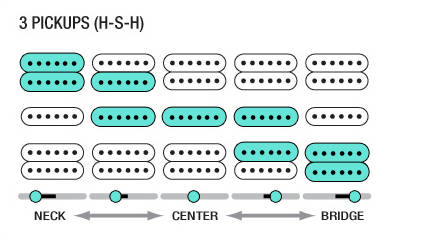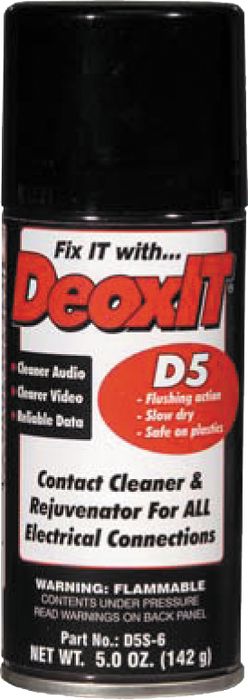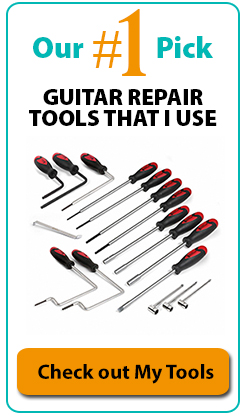Contents
Every electric guitar has a series of electronics that give the guitar its unique sound. Fender guitars signature sound comes from their five-way switches and single coil pickups where as Gibson Les Pauls comes from their three way selectors, multiple tone knobs, and humbucker pickups. Many other aspects of electric guitars affect the tonal qualities of the instrument, but the electronics cannot be overlooked. In this article, I will talk about different electronics in electric guitars as well as some common repairs. For more information about electric guitar pickups, see the electric guitar pickup page.
What are Electric Guitar Electronics?
Generally, the electronics in an electric guitar consist of four different components: pickups, pickup selectors, volume pots, and tone pots. Click the links below to read about each on of these components.
- Electric Guitar Pickups
- Electric Guitar Pickup Selectors
- Electric Guitar Pots
- Common Electronic Problems and Repairs.
Electric Guitar Pickups
Electric guitar pickups are the “microphones” of the guitar. The pickups pick up the sound waves coming from the strings and send them to the effect pedals and eventually to the amp for amplification. I have written an entire article about electric guitar pickups and repairs. For more information, see the electric guitar pickup page.
Electric Guitar Pickup Selectors
As the name implies, a pickup selector is a toggle switch that controls which pickups are being used. Since most electric guitars have at least two pickups, a pickup selector is a crucial piece of the overall tone of your guitar. Pickup placement will create different tones; thus, switching between the bridge and neck pickups will allow you to change the tone of your guitar. With multiple pickups, there are many pickup selection combinations.
Different kinds of Pickup Selectors
There are many different kinds of pickup selectors. The most common forms of pickup selectors are 3-way and 5-way switches. Obviously, a 5-way switch gives you more pickup combinations than a 3-way switch. Below are some diagrams of what 3-way and 5-way pickup selectors can do. In choosing a pickup selector, I suggest that you try to replace your pickup selector with the same kind of selector. Refer to the manufacturers website and wiring diagram to get the right specifications. Notice I said to get the same “kind” — not the same one. It would make no sense to replace a cheap selector with another cheap selector. Find out the specs on the old selector and buy a nice one.
How a Pickup Selector Works
 A pickup selector is a fairly simple electronic switch that is hardwired to both the guitar pickups and eventually the guitar jack. When the switch is flipped in a direction, the switch connects the lugs wired to the pickups and the jack completing the circuit.
A pickup selector is a fairly simple electronic switch that is hardwired to both the guitar pickups and eventually the guitar jack. When the switch is flipped in a direction, the switch connects the lugs wired to the pickups and the jack completing the circuit.
This is how the pickups are selected. While one or a combination of pickups is selected, the other pickups are deselected by the same means. As you can see in the diagram to the left, the pickup selection changes as the lever is pushed left or right.
How to replace a Pickup Selector
Pickup selectors can wear out over time. The lugs and the rotating switch can loose their tight connect with years of use. Also, many inexpensive guitars made today use cheap electronic parts. You may just want to upgrade your switch for more control and better selections. It is fairly easy to install a new pickup selector. Here are a few simple steps to replacing your pickup selector.
Remove the old Selector
Most pickup selectors are either mounted to the top of the guitar through a cavity routed in the back of the body or mounted to a pickguard. For pickup selectors that are mounted to the top of the body, simply take a screwdriver and unscrew the pickup selector. You will have to remove the knob on the end of the level before you can slide the selector through the channel and out of the cavity. For pickguard mounted selector, like Fender Stratocasters, you will need to remove the entire pickguard to remove the selector. Simply unscrew the pickguard from the body, flip it over, and rest it on the top of the body. The pickguard will still be wired to the body, so you can’t go very far with it. Then, unscrew the selector. It is important that you take note of what wires are soldered to what lugs before you remove the selector. If you are not familiar with electric guitar wiring, I suggest that you draw a picture of the selector and label the soldered wires. Once you know where everything has be wired, you can cut the wires close to the lugs and remove the old selector.
Install the new Selector.
Once the old selector is removed, screw the new selector in place. Follow your wiring notes from the old pickup selector, strip the wires with a pair of wire strippers, and solder the wires to the correct lugs. After everything is soldered in place, reattached the cavity cover or pickguard. For more information about how to solder wiring, see the soldering page.
Electric Guitar Pots
You may hear many guitarists or repairman talk about pots. What are pots? The word “pot” is short for potentiometer. A potentiometer is a simple electronic device that adjusts the flow of electric current. Most pots are basically glorified resistors. There are two outer lugs that carry the voltage to and from the pickups. The middle lug is a “swipe” lug that resists the voltage. When the knob is turned, the swipe resists more or less voltage allowing the volume to decrease or increase. Both volume and tone knobs are pots. The only difference between these two pots is that the tone pot has a capacitor soldered to the ground lug. The capacitor short-circuits the high frequencies disallowing them from reaching the output jack and eventually the amp. Your guitar will sound less trebly the smaller the resistance of the tone pot before the capacitor. For a more technical description of a capacitor, see the electric guitar capacitor page.
Different kinds of Pots
There are many different kinds of electric guitar pots out there. Each style of pot serves the same purpose but is customized for a particular guitar. For more information about the different kinds of pots and how to choose what kind of pot to install in your electric guitar, see the electric guitar potentiometer page.
How to replace electric guitar pots
Pots are just like any kind of electronic component on an electric guitar. Eventually, they will wear out or break and will need to be replaced. Replacing electric guitar pots is just as easy as replacing pickup selectors.
Remove the Knobs
First, remove the knobs of the pots that you want to replace. Some knobs are held in by setscrews. Look around the shaft of the knob to see if there is a screw head then unscrew the screw and remove the knob. Most knob are mounted on split shaft pots. There are no setscrews on a split shaft pot. Friction and pressure hold the knobs on the shafts in this case. You can pull the knob directly off the shaft of the pot since there is no screw. If the knob is stuck on the shaft, I usually use heavy gauges guitar picks to try to pry up the knob. You may also wrap a thin rag around the bottom of the knob and pull the knob off the shaft. Regardless how you get the knob off, be careful not to dent or ruin the finish on the top of the guitar. It is easy to rip the knob off of the pot and accidentally drop it on the guitar. Once the knob is removed, you can unscrew and remove the nut on the top of the shaft.
Replace the old Pot
Second, just like removing the pickup selector, you will need to access the back electronics cavity or remove the pickguard. Refer to the pickup selector section for more details. Take note of what wires are soldered to what lugs before you remove the pot. If you are not familiar with electric guitar wiring, I suggest that you draw a picture of the selector and label the soldered wires. Once you know where everything has be wired, you can cut the wires close to the lugs and remove the old pot. Then you can bolt the new pot in place, solder the wires on the lugs, replace the cavity covers or pickguard, and replace the knob. For more information about how to solder wiring, see the soldering page.
Common Electric Guitar Electronic Problems and Repairs
Most problems with electric guitar electronics are not caused by faulty parts. The majority of repairs that I see are simply wiring problems.
Wiring Problem Symptoms.
Your electric guitar keeps cutting out.
Guitar signals cutting out is a very common symptom of a simply wiring problem. Usually when your guitar cuts out, it means that you have a loose solder somewhere. Your guitar will sound fine when the solder connection is joined, but your guitar will cut out when the loose wire disconnects for the lug. Broken solder joints are common on electric guitars especially when your output jack becomes loose and rotates in the pocket. That is why it is extremely important to keep your output jack tight and secure at all times. If your output jack is loose and rotates, it will probably break the wiring connections inside the guitar. Luckly, loose connections are easy to fix. The only problem is trying to find them.
How to repair Loose Solder Connections.
First, plug your guitar in and toggle all the switches and knobs. If your guitar still plays fine, the connection problem is internal. Second, for non-Stratocaster style guitars, remove the cavity covers on the back of the guitar. Strum the strings and move the wires that are soldered to the switches, pots, and output jack. You will probably find your loose connection when the guitar cuts out again. For Stratocaster style guitars, you will need to remove the pickguard and manually check each connection point to make sure the solders are solid. Third, re-solder the loose wire and screw the cavity covers or pickguard back on. For more information about how to solder wiring, see the soldering page.
Pot Problem Symptoms – How to Clean Your Electric Guitar Pots.
Your electric guitar crackles as you turn the volume or tone knobs.
 Electronic crackling is a very common problem in electric guitars. Most likely, electronic crackling has very little to do with wiring. Usually the reason your guitar is crackling when you adjust the volume or tone knobs is because the pots are bad or dirty. Before you go and replace the pots on your electric guitar, I would try to use some Deoxit cleaner to see if the pots are just dirty.
Electronic crackling is a very common problem in electric guitars. Most likely, electronic crackling has very little to do with wiring. Usually the reason your guitar is crackling when you adjust the volume or tone knobs is because the pots are bad or dirty. Before you go and replace the pots on your electric guitar, I would try to use some Deoxit cleaner to see if the pots are just dirty.
To clean your pots, simply remove the knobs and spray some Deoxit into the pot where the shaft turns. It doesn’t take a lot of Deoxit to get the job done. Then, turn the knob a back and forth a bunch of times to work the Deoxit into the pot. Make sure to clean off the leftover Deoxit off the top of your guitar before you replace the knob.
If the crackling still persists, you may have to replace your pots. Refer to the pot section for more information about how to install new pots.
Wiring Diagrams.
If you are looking for a specific guitar wiring diagram, I would contact the manufacturer of your guitar. Most guitars have similar style wirings. If you have a Stratocaster style guitar that is made by another company, I would go ahead and just use a Strat wiring diagram. I have listed a few books on electric guitar wiring in my book section. Go to the electric guitar pickup wiring section for more information.



I am rewiring an Ibanez Gio GAX70, bought from a garage sale. It needs new parts, but in removing the wiring harness, I found the ground wire attaches to the bridge post, but I don’t find a way to get to that bridge post. The wire goes into a small hole in the body and that’s it. How do I put in a new ground?
The small hole leads to the the rear claw, just solder the wire to the claw for ground.
Hy Guys!
I have rewired my guitar with new pickups, it all works ok, but there is a slight buzz that changes when I touch anything connected to ground ! ( strings, bridge, toggle switch etc). Not sure what to do ?? Please help me.
Thanks and regards, Rod.
Rod, use an ohmmeter to check continuity between the metal parts you mention and the ground side of the output jack. Ed
Super useful and descriptive, thanks!